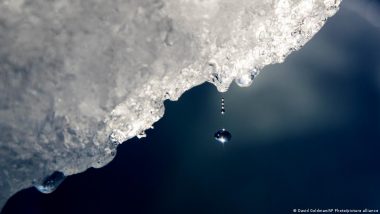Ice sheets in Greenland and the Antarctic are shedding triple the ice than 30 years ago due to global heating. This polar meltdown could double sea level rise.Greenland is a huge region in the Arctic, and the world's biggest island, that is usually frozen. But as temperatures in the far north rise faster than most other places, its massive ice sheets are melting into a warming ocean.
Also Read | India News | Bike Taxis to Get Legal Recognition in Delhi, Kejriwal Approves New Cab Aggregators Scheme.
One recent study showed that Greenland is the warmest it's been for 1000 years. The resulting Arctic meltdown was responsible for 40% of the world's rising seas in 2019.
Also Read | India News | Amartya Sen Land Case: District Court Fixes Hearing on May 30.
Scientists are concerned that Greenland's Petermann glacier is breaking up. Sitting on the edge of the ocean, its retreat will expose massive ice sheets behind it to warming ocean water. Researchers who have been studying the glacier said that projected sea level rise could double as a result.
Rapid retreat of the planet's largest ice sheet will be scary for low-lying islands and coastal areas that are vulnerable to sea level rise. But in Greenland itself, the Indigenous Inuit people are literally living on thin ice, which means a loss of habitat for local wildlife like seals, bears and walruses.
In the southern polar region, Antarctica, sea ice was increasing in size by about 1% per decade since the 1970s. But last year, it was at its lowest ever recorded level.
There are fears that the Thwaites glacier, which is the size of Florida and the biggest chunk of ice on the planet, is starting to crack up due to warming Antarctic waters.
But the southern polar region is so isolated that scientists are still trying to figure out how bad it could get.
Why is the Arctic melting so fast?
During the forty-odd years between 1979 and 2021, the Arctic warmed four times more than the rest of the globe, say scientists.So it's unsurprising that two-thirds of global ice melt is happening in Greenland, researchers have now confirmed.
It's so bad that most of the epic Greenland Ice Sheet is expected to melt if the world heats up by 1.6C more than when industrialization began around 250 years ago — right now we at around 1.2C. Once that happens, sea levels could rise by seven meters.
It is believed that the Arctic is warming faster than the Antarctic because there is a lot more surrounding liquid water in the region during summer and autumn when sea ice declines. This water absorbs sunlight — as opposed to ice, which reflects it — and the ocean warms as a result.
Since the Arctic is an ocean and consists mostly of sea ice, it has also been affected more by rising ocean temperatures than the Antarctic, which consists mostly of ice-covered land.
In addition, the ocean currents in the Southern Ocean tend to bring up deep cold water that keeps the Antarctic region relatively cool.
Still, ice melt in the Antarctic is up around 65% from the 1990s.
Mountain glaciers are also disappearing
Polar glaciers aren't the only victim of global heating caused largely by burning fossil fuels that emit greenhouse gases.
The world's mountain glaciers, which number roughly 200,000, are melting much faster than they can accumulate these days. Problem is, though they only cover less than 0.5% of the Earth's landmass, these "water towers" provide fresh water to about a quarter of the world's population.
Glaciers also feed the rivers that irrigate the crops which hundreds of millions of people across Asia, South America and Europe depend on for their survival. So without them, many people will suffer from both thirst and hunger.
Scientists say that water tower retreat has put almost 2 billion people at risk of water scarcity.
South American cities like Santiago in Chile have seen much of their drinking water supply literally dry up as glaciers in the nearby Andes retreat.
Meanwhile, the European Alps that supply so much fresh water across the region have shrunk by about half since 1900 and will be almost ice free by century's end if nothing more is done to curb warming.
Dark ice melting faster than clean ice
Glaciers covered in rock and dirt tend to melt faster than cleaner ice because the dark matter absorbs more energy from the sun.
These stones and rocks can heat up as high as 40C in high elevations, say researchers.
When the ice melts as a result, broader glacial meltdown can be the result.
But an emerging problem in the western Greenland ice sheet is the unexplained arrival of a purple algae that is darkening the ice surface and absorbing more sunlight.
These algae blooms turn purple to shield themselves from UV radiation but then turn a sooty black, which intensifies the heating.
Edited by: Sarah Steffen
(The above story first appeared on LatestLY on May 10, 2023 07:00 PM IST. For more news and updates on politics, world, sports, entertainment and lifestyle, log on to our website latestly.com).













 Quickly
Quickly











